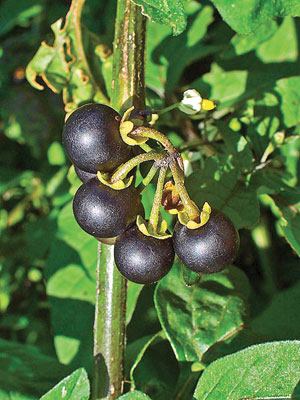Dangers could be lurking in pastures across the Ozarks, dangers that can be fatal to livestock.
There are many plants commonly be found in pastures, both native and improved, along fence rows and other areas that are potentially toxic to livestock, such as water and poison hemlock, black nightshade, wild cherry and milkweed.
Luckily, many of these plants taste bad, so livestock doesn’t typically graze upon them.
“If you haven’t mowed your hay and knocked them down, now is the time to start looking for poisonous plants,” University of Missouri Extension Agronomy Specialist Terry Halleran, who is based in Hickory County, Mo., said. “Most of them, the cows won’t eat unless they are forced to eat them; things like hemlock, nightshade and such. They really don’t go looking for them.”
Most plants are only dangerous during certain periods in their life cycle, and may be perfectly fine after being cut in hay. For example, the leaves and stems of buttercups contain toxins, but those toxins volatilize upon drying; therefore, buttercups contained in dried hay do not pose toxicity problems.
Mature Johnson grass in well-dried hay also poses no danger to cattle.
Halleran added that there are several resources available for producers to help identify dangerous plants, and what control measures work best to eliminate those plants from pastures.
“Most of them are broadleaves and can be controlled with a broadleaf spray,” he said. “You don’t have to get the high-dollar stuff, 2-4-D will usually take care of them.”
Halleran added that spraying at the right time during the plant’s growth cycle is also important for eliminating the threat.
“You want to make sure there is enough leaf surface for the chemical to get on it and be absorbed,” he said. “If you are spraying before (the plant) gets to be about 4 inches or so, you may not get as good a kill as you might like, but you need to get them sprayed before they get to be 12 inches or so. Timing also has a lot to do with it, depending on if it is a cool or warm season plant, a C3 or a C4 plant, or the time of year when you spray.”
The most important tool in fighting poisonous weeds. Halleran suggested is education.
He went on to say that university Extensions and chemical companies offer a wide range of literature, many times at no cost, to producers to help identify poisonous plants and invasive weeds, as well as tips for control measures for a particular species.
Halleran also said produces should educate themselves on the products they use in fields and pastures.
“There are some restrictions on when you can turn cattle out on the area, how soon you can hay it, and they are different for beef and dairy cattle,” he cautioned. “Also, there are restrictions on how soon you can reintroduce any type of new seed for legumes. If you put Grazon in a field, you can’t put in red cover for 15 to 18 months because it will kill it. Read the entire label, not just the part with how to put it on and what it kills. Don’t skip things.”
Some producers, he added, have been able to utilize their rotational grazing systems to control toxic plants.
“I hear people say they are able to control it because they flash graze and the cattle tromp it down, so they don’t have to worry about it,” Halleran said. “The cattle will go for the grass first.”
Producers should also be aware of any shrubs, non-native or ornamental plants that may be in pastures. Boxwood shurbs, for example, are highly lethal to livestock. When pruning shrubs or trees, it is important that livestock has no access to clippings. Wilted leaves cut from a bush or tree can actually be more toxic the live plant.
If the ingestion of a poisonous plant is suspected in a dead or ill animal, Halleran recommended that producers scout their pastures for any suspect plants. If they are unsure which plants might be the culprit, he advised that the producer contact their local Extension center for assistance.
For more information on plants that can be harmful to livestock, go to ozarksfn.com and go to the “Extended Stories” link.






